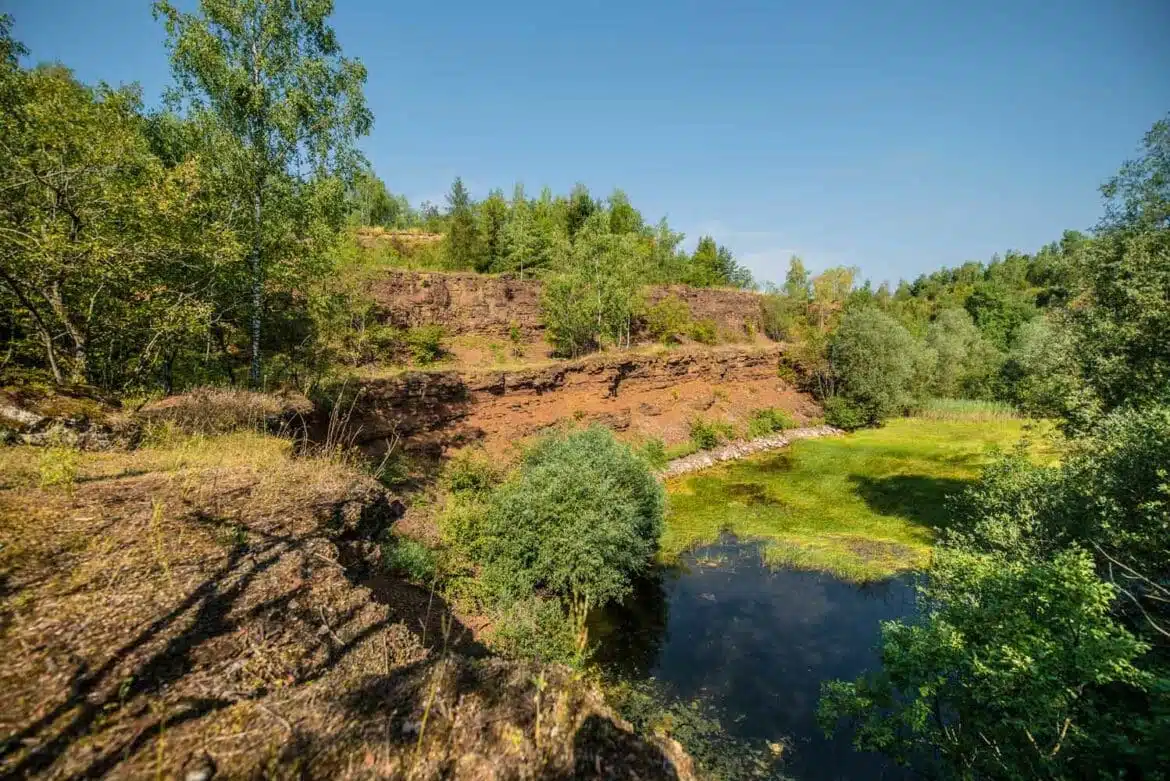In the South of Luxembourg, the so-called Minette region, iron ore was still mined until the end of the 1970s. The land of the red rock,also called “Terres rouges” take its name from the shining, red iron ore. Over the years, nature has reclaimed the former pit landscape and a surprising number of rare plants and animals can now be found in what is a partly bizarre, human-forged landscape.
If the Minett region conjures up furnaces, industrial land- scapes and soot blackened manufacturing cities, prepare to let the plentiful green, the peace and seclusion that you will find in the rewilded mines surprise you. KACHEN went to visit the nature reserve “Prënzebierg – Giele Botter”, which is, since 1978, an abandoned open pit mine and which still shows traces of its industrial past. Yet today, red is not the dominant colour anymore, instead it is green. The area is shaped by different stages of plant de- velopment and numerous biotopes, which boast rare fau- na and flora.
From industry to nature
Since 1991, the 255.30 ha of the “Prënzebierg – Giele Botter” are protected. The return of the industrial site to nature has taken several steps. Depending on the time of the abandonment and the existing bedrock different succes- sion stages have taken place and distinct bio diversity has developed. The widespread areas of erstwhile naked rock and rubble were mostly left to themselves. In the 1970s, 168 000 trees were planted sporadically as part of a reforestation programme set up to speed up the natural process. After moss and lichen, grassland developed, followed by pioneer species such as birch and willows. Over time, a mosaic of different biotopes with very specific microclimates developed. Mounds overgrown with ferns and orchids dominate this landscape, which is unique in Luxembourg. Not for nothing this region is described as a paradise by locals.
You can explore this unique nature reserve in two ways. The circuit route, “Prënzebierg – Giele Botter”, which has a length of 7.6 km, takes you over the former terraces used by the lorries carrying ore, the “Buggien”, past steep rock walls, mounds of rubble and quarries, all with diverse lo- cal conditions. The path takes you past ponds and wetlands, as well as dry grasslands, pioneer forests and shady lime scale beech forests. Rare orchids, such as the wild spotted orchid, find ideal growing conditions in the wet grasses of this nature reserve. Overall, 21 orchid species grow here, as well as the rare holly fern. The crested newt and swallowtail are also at home here.
The geological nature trail, “Giele Botter” has a length of 2.6 km and takes you through the centre of the reserve and is only reachable via the discovery trail. Walkers and amateur geologists will find numerous plaques along the former quarry walls of the open pit mine, “Giele Botter”, informing visitors on interesting facts about the creation, characteristics and mining of the layers of the Minette. You can download a detailed brochure on the history as well as fauna and flora of the reserve, “Prënzebierg – Giele Botter” on nature.lu
A discovery trail in the RedRockRegion
The 15 communes in the Minettregion – the RedRock- Region – offer numerous other walk ways and scenic beauties and, of course, many insights into the industrial past of the South. On the way, you will come across the old gallery systems, the “Minièresbunn”, the “Léiffrächen”, and always a lot of nature. Find the brochure, RedRock Walks, and all information on the RedRockRegion on redrock.lu and in the Office Régional du Tourisme Sud, tel: +352 27545991.




